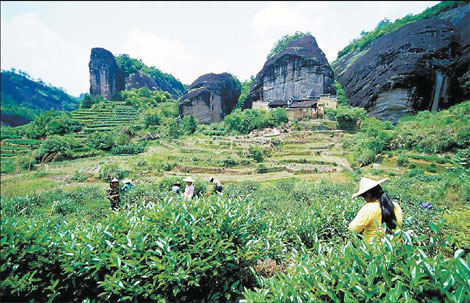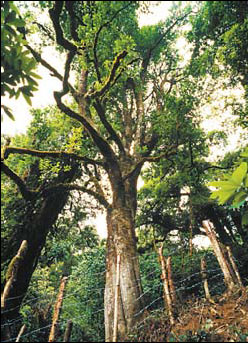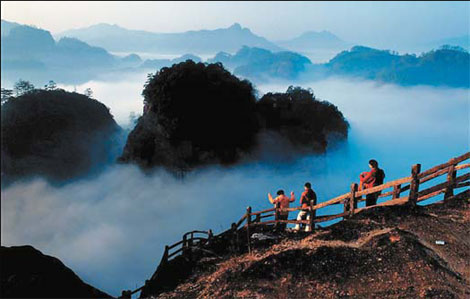
A tea plantation on the Wuyi Mountains. Photos from Quanjing
Some of China's best sightseeing destinations also produce the country's best teas. So take advantage of the Chinese National Day holidays to check out the great sights and sip the teas while you're at it.
Autumn is the best time of year for oolong and the pick of the crop is now to be found in East China's Fujian province. Four famous Chinese oolong teas are tieguanyin (Iron Goddess of Mercy), produced in southern Fujian; dahongpao (big red robe) in northern Fujian; fenghuang (phoenix) dancong oolong in Guangdong province, and dongding (top-frozen) oolong in Taiwan.
It is the best time of year to visit the Wuyi Mountains, which produce the four most famous northern Fujian oolong teas: dahongpao, also called "rock teas" as they grow on cliffs; baijiguan (white cockscomb); Wuyi rougui (rock teas with cinnamon flavor); and Wuyi shuixian (rock teas with the scent of narcissus flowers).
Oolong tea is half fermented and looks dark green. Because they grow on the mountains, northern Fujian oolong teas are known for their floral fragrance and a "rock rhyme". They taste strong, round and have a descending power in the body, which people call "the bone of rocks". The fragrance lingers long in the mouth.
The big red robe tea got its name from a story. A Chinese scholar in the Ming Dynasty (1368-1644) was passing through Fujian when he fell sick with a stomachache.
Local monks offered him a cup of tea and cured him, so that he not only took a national qualifying exam for officials but also became the top qualifier. He also used the tea to cure the Queen's stomach problem. He later returned to Fujian and tied a red robe of honor on the tea tree.

Wild tea trees that are more than 1,000 years old can be found in the southernmost part of Yunnan province.
While the dahongpao is the most famous northern Fujian oolong tea, Wuyi rougui is known for its great fragrance and Wuyi shuixian for its good taste. The rock teas are best for people who want to lose weight and get rid of that heavy feeling in the stomach.
Be warned, though - they also reduce blood sugar so fast, that you can suddenly end up with a low blood-sugar level and become weak in the limbs or even dizzy, if you drink too much on an empty stomach. If that happens, eat some candy, or some snack food.
The Wuyi Mountains have a typical danxia topography, characterized by a distinctive red sandstone land formations. It is said that the 36 peaks and 99 famous rocks all produce good oolong.
Tieguanyin, another famous oolong tea in southern Fujian, is also in its prime now. Its home region, Anxi, has a tea farming history dating back to the Tang Dynasty (618-907) and produces 15,000 tons of oolong in 16,700 acres of tea gardens. Most of the population is involved in tea cultivation.
Tieguanyin has a pure, refreshing orchid fragrance and a dark green color resembling iron. It got its name from Wei Yin, a local tea farmer in the Qing Dynasty (1644-1911), who believed that the Goddess of Mercy helped him discover this special kind of tea.
Today, the rock on a hill where Wei dug the first sprout of tieguanyin is a tourist destination. On the way there, you can spend time at numerous tea farms, see how tea is picked and how it is made through a complicated process of bruising, shaping, roasting and drying.
Also visit the local wholesale tea market, which is called Tea Capital. There you can see tea farmers bringing their products and experts judging the quality. In April and November, a Tea King contest is held to select the best teas of the year.
Fenghuang Town in the north of Chao'an, Guangdong, produces a very special oolong tea, fenghuang dancong (phoenix single tree), so called because each of its many tea types is often produced on only one tree, with a very small harvest.
Phoenix single tree has probably the world's most diversified natural fragrances, with at least more than 100 kinds of natural tea fragrances.
Many of the teas are named after their fragrances. Milanxiang has the smell of orchid and the taste of honey. Guihuaxiang has the fragrance of sweet-scented osmanthus. Many other categories have the scents of different fresh flowers.
With more than 900 years of tea farming history, the area probably has more old tea trees than anywhere else in the country - 3,700 trees more than 200 years old.

Travelers visit the Wuyi Mountains for spectacular natural scenery and fine oolong tea.
Although green tea is picked in late March and early April, you can also drink and buy it now. Visit East China's green tea-producing regions, like Hangzhou's West Lake, famous for longjing (dragon well) tea, and Anji for Anji Baicha, an intensely refreshing green tea. Yixing produces both green tea and black tea, as well as famous clay teapots. Suzhou's Taihu Lake area has the famous biluochun green tea.
Jasmine tea is made in August, when jasmine flowers bloom. The most famous place to visit is Guangxi's Hengxian county, which is a big jasmine-producing region. Guangxi's Liuzhou and Liubao, and Hunan's Dongtinghu Lake area produce black tea. Yunnan's Pu'er, Xishuangbanna and Menghai produce pu'er tea.
Good mountains and good waters produce good teas. While you are touring these beautiful places of China, sipping the great teas they offer will further your understanding of local people's lives and culture.

Editor: canton fair |




